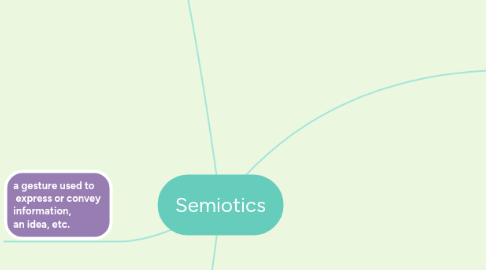
1. a gesture used to express or convey information, an idea, etc.
2. Semioticians
2.1. Charles Sanders Pierce
2.1.1. Peirce’s seminal work in the field was anchored in pragmatism and logic.
2.1.2. He defined a sign as “something which stands to somebody for something,”
2.1.3. and one of his major contributions to semiotics was the categorization of signs into three main types:
2.1.3.1. Symbol
2.1.3.2. Icon
2.1.3.3. Index
2.2. Ferdinand De Saussure
2.2.1. treated language as a sign-system
2.2.2. his work in linguistics has supplied the concepts and methods that semioticians apply to sign-systems other than language
2.2.3. Saussure’s distinction between the two inseparable components of a sign
2.2.3.1. signifier, which in language is a set of speech sounds or marks on a page.
2.2.3.2. the signified, which is the concept or idea behind the sign.
2.3. Ronald Barthes
2.3.1. His first book, Le Degré zéro de l’écriture was a literary manifesto that examined the arbitrariness of the constructs of language
2.4. Is the principal exponent of deconstruction, a term he coined for the critical examination of the fundamental conceptual distinctions, or “oppositions,”
2.5. Barthes’s intellectual stature was virtually unchallenged, and his theories had become extremely influential not only in France but throughout Europe and in the United States.
2.5.1. Some thought his theories contained brilliant insights, while others regarded them simply as perverse contrivances.
2.6. Jacques Derriba
2.6.1. An analysis shows that the opposition is not natural or necessary but a product, or “construction,” of the text itself.
2.6.2. The speech/writing opposition, for example, is manifested in texts that treat speech as a more authentic form of language than writing.
2.7. Emile Benveste
2.7.1. The I–you polarity is another important development explored in the text
2.7.2. A pivotal concept in Benveniste's work is the distinction between the énoncé and the énonciation, which grew out of his study on pronouns.
2.7.2.1. The énoncé
2.7.2.1.1. The énoncé is the statement independent of contex
2.7.2.2. The énonciation
2.7.2.2.1. The énonciation is the act of stating as tied to context.
3. Definition of a sing
3.1. Saussure's model of the sign refers only to a concept and not to a thing. signified =The concept it represents signifier =The form the sign takes •written •spoken •visual •auditory
3.1.1. Paradigmatic Relationship
3.1.1.1. Have two leves
3.1.1.1.1. At the level of the signifier: ☆same prefix or suffix, words that rhyme, and homonyms
3.1.1.1.2. At the level of the signified: synonyms and antonyms.
3.1.2. Syntagmatic Relationship
3.1.2.1. The relations which a sign entertains with the other signs that surround it within a concrete signifying instance. These relationships can only be realized in the discourse, and they always involve formal proximity (grammar).
3.2. Saussure's
3.3. Pierce's
3.3.1. Three types of signs
3.3.1.1. Symbol The signifier does not look like the signified (fundamentally arbitrary or purely conventional)
3.3.1.1.1. Examples of symbol One example are colors
3.3.1.2. Icon The signifier is Perceived that is Look like or imitating The signified
3.3.1.2.1. Example of icon One examples smoke
3.3.1.3. Index Signifier is directly Connected in some way (Physically or causally) To the signified.
3.3.1.3.1. Examples of index One example is the fire
3.4. Barthes's
3.4.1. Signifying System
3.4.1.1. Denotation (First orden signifying)
3.4.1.1.1. The meaning you get from a dictionary.
3.4.1.2. Connotation (Second order signifying)
3.4.1.2.1. The idea or interpretation you have about a word.
3.5. Jacques's
3.5.1. Theories
3.5.1.1. ☆He deals more with the analysis of written texts. ☆The signifiers (words) mean more than the signifieds given (dictionary)
3.5.1.1.1. It means connotation based on history, period, social class, culture, etc.
3.6. Emile's
3.6.1. He add "subjectivity" to the lenguage structure
3.6.1.1. He explained about the speaking subject (referent)= writer or speaker, and the subject of speech (referee) = “I” in discourse the word spelled “I.”
3.6.1.1.1. Two levels
